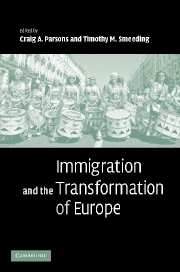Book contents
- Frontmatter
- Contents
- List of figures
- List of tables
- List of contributors
- Acknowledgements
- 1 What's unique about immigration in Europe?
- 2 Europe's immigration challenge in demographic perspective
- 3 Migration into OECD countries 1990–2000
- 4 Divergent patterns in immigrant earnings across European destinations
- 5 Economic consequences of immigration in Europe
- 6 Occupational status of immigrants in cross-national perspective: A multilevel analysis of seventeen Western societies
- 7 Immigrants, unemployment, and Europe's varying welfare regimes
- 8 How different are immigrants? A cross-country and cross-survey analysis of educational achievement
- 9 Immigration, education, and the Turkish second generation in five European nations: A comparative study
- 10 Managing transnational Islam: Muslims and the state in Western Europe
- 11 Migration mobility in European diasporic space
- 12 The new migratory Europe: Towards a proactive immigration policy?
- 13 European immigration in the people's court
- 14 The politics of immigration in France, Britain, and the United States: A transatlantic comparison
- 15 “Useful” Gastarbeiter, burdensome asylum seekers, and the second wave of welfare retrenchment: Exploring the nexus between migration and the welfare state
- 16 The European Union dimension: Supranational integration, free movement of persons, and immigration politics
- 17 The effectiveness of governments’ attempts to control unwanted migration
- Index
- References
4 - Divergent patterns in immigrant earnings across European destinations
Published online by Cambridge University Press: 23 June 2009
- Frontmatter
- Contents
- List of figures
- List of tables
- List of contributors
- Acknowledgements
- 1 What's unique about immigration in Europe?
- 2 Europe's immigration challenge in demographic perspective
- 3 Migration into OECD countries 1990–2000
- 4 Divergent patterns in immigrant earnings across European destinations
- 5 Economic consequences of immigration in Europe
- 6 Occupational status of immigrants in cross-national perspective: A multilevel analysis of seventeen Western societies
- 7 Immigrants, unemployment, and Europe's varying welfare regimes
- 8 How different are immigrants? A cross-country and cross-survey analysis of educational achievement
- 9 Immigration, education, and the Turkish second generation in five European nations: A comparative study
- 10 Managing transnational Islam: Muslims and the state in Western Europe
- 11 Migration mobility in European diasporic space
- 12 The new migratory Europe: Towards a proactive immigration policy?
- 13 European immigration in the people's court
- 14 The politics of immigration in France, Britain, and the United States: A transatlantic comparison
- 15 “Useful” Gastarbeiter, burdensome asylum seekers, and the second wave of welfare retrenchment: Exploring the nexus between migration and the welfare state
- 16 The European Union dimension: Supranational integration, free movement of persons, and immigration politics
- 17 The effectiveness of governments’ attempts to control unwanted migration
- Index
- References
Summary
Introduction
Western Europe, which used to think of itself as a region of emigration, has experienced substantial net immigration in the last four decades from the lesser-developed countries of Asia, Africa, Latin America, and in the last decade, from the former Eastern bloc countries. As a result, immigration has become an important socioeconomic and public policy issue in all of the developed European economies. Understanding how well immigrants from different origins adapt to diverse labor markets across Europe, and whether labor market outcomes, such as earnings, occupation or unemployment among immigrants differ by country of destination, country of origin and gender is of public policy interest.
The analysis of earnings of the immigrants began with the study of white men in the United States (Chiswick 1978), but was quickly followed by analyses for a range of racial and ethnic groups, countries of origin and for women (Chiswick 1979, 1980; Long 1980). While the literature has spread to nearly all destination countries, most studies deal with immigrants in the English-speaking developed countries of overseas settlement (United States, Canada, and Australia) and tend to concentrate on only one country, thereby making comparisons across destinations very difficult.
This study builds on the existing literature, but takes a different approach. Unlike the standard literature on the adjustment of immigrants that focuses on one destination at a time, and often one origin and one gender at a time, this study emphasizes the comparison across destination countries, as well as across countries of origin and gender.
- Type
- Chapter
- Information
- Immigration and the Transformation of Europe , pp. 85 - 110Publisher: Cambridge University PressPrint publication year: 2006
References
- 7
- Cited by



